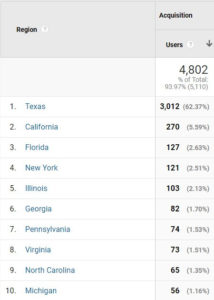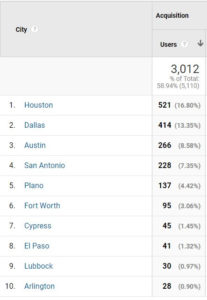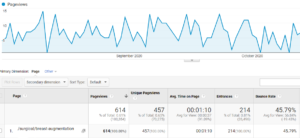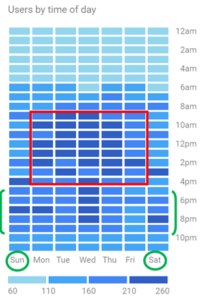

Regardless of the candidates you voted for or the issues on your ballot, we all experienced “election exhaustion” from this year’s election. But there are takeaways that you can apply to your medical marketing that uncovers hidden issues, but more importantly, new opportunities.
Elections can be confusing and downright frustrating when it comes to finding the truth. Even when accurate figures are used, the same data can tell two completely opposite stories.
The same can be said for your marketing results, including your Google Analytics user data.
Most doctors get a Google Analytics report from their agency each month. If traffic is up or stable, that is all they feel they need to know. Although the data may be accurate, it may not be telling you the truth about your marketing results. Like good medicine, analyzing data is key to know where you stand and how to get better.
The first step is to make sure your practice has access to your Google Analytics account. If you do not have it, you can easily request it from you webmaster.
So what should you be analyzing? Here are some higher-level tips.
Traffic vs. Local Visitors
Probably the most common misdiagnosed or overlooked issue is assuming overall traffic numbers is the primary Key Performance Indicator (KPI) of your website marketing results. Although it is important on several levels, what most practices need to know is how many of those visitors are potential new patients. The first qualifier: Are they local? Even providers and practices that have developed a national or international reputation and attract patients from around the world need to reach prospects locally.
For instance, a practice in Austin, TX indicated it was not getting many leads, yet the website was getting 4,802 users per month. So, they assumed the problem was not marketing, but the website design and calls-to-action.
Although the website may still be an issue, the bigger problem is likely marketing. After drilling down, we found only 266 users were from the Austin area (5.5 percent of total visitors; 8.6 percent of visitors from Texas)!


Of course, we all recognize that local visitors are far more likely to convert into actual leads and schedule consultations. But these visitors also send strong “local” signals and typically have higher performing user engagement for Google rankings:
By uncovering and identifying your local visitors, you can more accurately understand how your website and marketing are performing, and then take steps to improve the appropriate area(s).
In your Google Analytics account you can access this through your dashboard: Audience>Geo>Location>Country>City
Pageviews vs. Page Views
The overall number of pages users visit (pageviews) is important, but all pages are not equal. How specific high-priority pages perform is probably more valuable when finding ways to improve Google rankings, page performance and lead generation.
Some things you can uncover when assessing your most important pages:

In addition to your high-priority procedure pages, some other other “prime” pages can include About Dr., Contact Us, Financing, Gallery sections, Your Consultation, etc. By understanding how your most important pages perform, you can begin prioritizing updates to your website and develop creative strategies to improve them.
You can find your page performance in your dashboard: Behavior>Overview (then click on “view full report” on bottom right corner)
Anytime vs. The Right Times
Like in any other type of marketing and advertising timing is everything. This is particularly true when it comes to how you convert more visitors into leads. It can also shed light on generating your most valuable type of leads – telephone calls.
First, we all know your staff are far more effective at converting telephone leads into scheduled consultations and patients. So, you must attract traffic during times when visitors know you are open and available – weekday working hours (see below in red). If you are not getting higher volume visits during these times, then you probably need to start looking into marketing options that can focus on these dayparts and generate them.

At the same time, we cannot dismiss visitors that come during after-hour dayparts and weekends, as well. If you are like most practices, you will also see some spikes in traffic during these typical non-business hours (above green). When users visit during these times they are not likely to call your office because they know you are closed.
Therefore, you need to provide other types of calls-to-action that can tee up sales calls for your patient care counselors during these off hours. In addition to email forms, high-conversion websites also leverage Live Chat and Text Messaging services that can be available 24/7 or during times when your office is closed.
Some practices that have never used these services lean towards only running them during closed hours. However, many visitors (even those during working hours) are not ready to call and would prefer to initially communicate with your practice digitally. This is particularly true with millennial and young family demographics. I also have clients and consultants who indicate that these types of leads convert at a higher rate than email form submissions. Thus, I suggest running them 24/7.
You can find your visitors by day and hours chart: Home page of your Google Analytics dashboard
Visits vs. Leads
Practices with high-volume website traffic generally generate more leads, but are they getting the most out of these valuable visits? In many cases, the fastest and most economical way to generate more leads and business is to convert the traffic that is already coming to your website. Simply relying on getting more and more traffic takes additional time and money.
However, to improve your conversation rate, you need the right data to guide your strategies. Thus, conversion tracking is one of your most important KPIs.
Historically, when most practices think of Google Analytics conversion tracking, the assumption is that it only tracks email form submissions. However, set up correctly, it can also track a much wider variety of website lead generation options. This includes phone analytics, Live Chats, and can even include SMS leads.
By identifying and setting up key conversion goals and tracking goal completions and conversion rate, you can start developing more data-supported strategies to design more compelling calls-to-action, create intuitive “next steps” links, and convert more visitors into leads.
To access your goal conversions through your Google Analytics dashboard: Conversions>Goals>Overview
Accountability vs. Opportunity
Most agencies send monthly Google Analytic reports and may even review them with you to provide a higher level of accountability for the dollars you are investing with them. This is an important, as your digital marketing investments are getting bigger and bigger.
However, if accountability is the only way you leverage Google Analytics data, it becomes a tool that creates complacency, or a bad report card that undermines your relationship with your agency partner. You end up missing out on your biggest opportunities. When used strategically, Google Analytics holds the key to finding the underlying problem to hard-to-determine issues, and unlocking new opportunities that were not even on your radar.
These are just the tip of the iceberg when it comes to navigating your way to higher ROI using data that is already at your fingertips.
*Want a Free Google Analytics Assessment?
Call (202) 851-8622 or request one online.